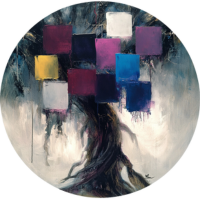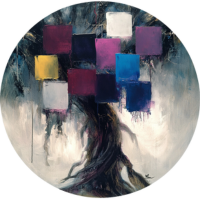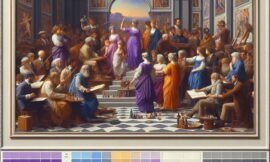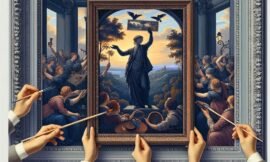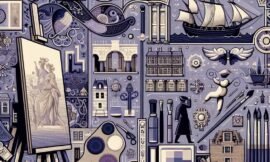As a busy artist, time is always of the essence. Finding efficient ways to create stunning artwork without spending countless hours can make all the difference in maintaining a healthy balance between creativity and productivity. In this blog post, we will explore time-saving painting techniques that can help you produce high-quality pieces in less time. From blocking in and palette knife painting to simplifying details, we’ve got you covered with expert tips and tricks to streamline your creative process.
Mastering the Art of Blocking In
What is Blocking In?
Blocking in is a foundational painting technique used to quickly lay down the general shapes, colors, and composition of your artwork. Instead of focusing on details initially, you create a rough outline of the entire scene, breaking it down into simple forms and broad areas of color. This method allows you to establish the overall structure and balance of your composition early on, saving you time in the long run.
Benefits of Blocking In
One of the primary benefits of blocking in is that it helps identify and correct compositional issues early in the process. By focusing on big shapes and general colors, you can make adjustments before investing time and effort into detailed work. This can prevent the frustration of fixing mistakes later on. Additionally, blocking in provides a solid foundation for adding details, textures, and fine-tuning your painting.
Practical Tips for Effective Blocking In
To effectively use the blocking in technique, start with a well-defined sketch of your subject. Use a larger brush or even a palette knife to apply broad strokes of color, focusing on the main shapes and shadows. Don’t worry about getting everything perfect at this stage; the goal is to create a rough framework for your painting. Once you have the main elements in place, you can gradually build up the details and refine your work.

Exploring the Versatility of Palette Knife Painting
Why Use a Palette Knife?
A palette knife is a versatile tool that can create bold, dynamic textures and effects in your paintings. Unlike brushes, which require more time and precision, palette knives allow for quick application of paint and can produce strikingly expressive results. Whether you’re working on a landscape, abstract piece, or portrait, incorporating a palette knife into your practice can significantly speed up your painting process.
Techniques for Palette Knife Painting
There are various techniques you can use with a palette knife to achieve different effects. For example, you can use the edge of the knife to create fine lines and details or use the flat side to apply broad swaths of color. Experiment with different angles and pressures to discover the range of textures you can create. One popular method is to layer thick, impasto strokes to add depth and dimension to your artwork.
Getting Started with Palette Knife Painting
If you’re new to palette knife painting, start by practicing basic strokes and techniques on a small canvas. Use thick, heavy-body acrylic or oil paints for the best results. As you become more comfortable with the palette knife, challenge yourself with larger compositions and more complex subjects. Remember, the key to mastering palette knife painting is to embrace spontaneity and let the texture and movement of the paint guide your creative process.
Simplifying Details for a More Efficient Workflow
Understanding the Importance of Simplification
One of the most significant time-saving tips for busy artists is to simplify details in your artwork. While intricately detailed pieces can be impressive, they often require substantial time and effort. By focusing on the essential elements and reducing unnecessary complexity, you can create high-quality artwork more efficiently. Simplifying details doesn’t mean compromising on quality; it’s about making deliberate choices that enhance the overall impact of your piece.
Strategies for Effective Simplification
There are several strategies you can use to simplify details in your paintings. One approach is to use larger brushstrokes and fewer layers to convey the essence of your subject. Another technique is to prioritize areas of focus and detail while using looser, more abstract forms for the background and less critical elements. By concentrating your efforts on the most important parts of your composition, you can achieve a balance between detail and efficiency.
Examples of Simplified Art Styles
Many famous artists have embraced simplification in their work, creating iconic pieces that are both time-efficient and visually striking. For example, Impressionist painters like Claude Monet and Vincent van Gogh used broad, dynamic brushstrokes to capture the essence of their subjects without getting bogged down in minute details. Similarly, contemporary artists such as David Hockney and Ellsworth Kelly employ bold, simplified forms and vibrant colors to create impactful compositions. By studying these artists and their techniques, you can find inspiration for incorporating simplification into your own practice.
Utilizing Digital Tools for Speed and Precision
Benefits of Digital Painting
With the rise of digital art, many artists are turning to digital tools to streamline their creative process. Digital painting offers several advantages, including the ability to quickly undo mistakes, experiment with different effects, and work with a wide range of brushes and textures. Additionally, digital tools can help you achieve a level of precision and control that is difficult to replicate with traditional media.
Popular Digital Painting Software
There are many popular software programs available for digital painting, each offering unique features and capabilities. Adobe Photoshop is a widely used program that provides a vast array of brushes, filters, and editing tools. Corel Painter is another popular choice, known for its realistic brush simulation and extensive library of textures. For those looking to create vector-based art, Adobe Illustrator is an excellent option. Each of these programs allows you to work efficiently and effectively, reducing the time and effort needed to produce high-quality digital paintings.
Integrating Digital Techniques with Traditional Art
Many artists find that combining digital techniques with traditional media can enhance their efficiency and creativity. For example, you can use digital tools to plan and sketch your composition before transferring it to canvas or paper. Additionally, digital painting can serve as a valuable tool for experimenting with colors, textures, and effects before committing to a final piece. By integrating digital techniques into your artistic practice, you can save time and achieve a more polished and professional result.
Adopting Efficient Work Habits and Environment
Creating an Organized Workspace
One of the keys to working efficiently as a busy artist is to maintain an organized and clutter-free workspace. Having easy access to your tools and materials can significantly reduce the time spent searching for supplies and setting up for your painting sessions. Consider investing in storage solutions such as shelves, drawers, and containers to keep your workspace tidy and well-organized.
Establishing a Consistent Routine
Establishing a consistent routine can help you make the most of your painting time. Set aside dedicated periods each day or week for your art practice, and try to stick to this schedule as closely as possible. Having a routine can help you stay focused and motivated, ensuring that you make steady progress on your projects. Additionally, consider breaking your painting sessions into shorter, more manageable blocks of time to maintain your energy and concentration.
Staying Inspired and Motivated
Finally, staying inspired and motivated is essential for maintaining an efficient and productive workflow. Surround yourself with sources of inspiration, such as art books, magazines, and online galleries. Take breaks to recharge and seek out new experiences and ideas. Connecting with other artists through social media or local art groups can also provide valuable support and encouragement. By keeping your passion for art alive, you can maintain the drive and determination needed to create high-quality artwork in less time.
Creating high-quality artwork as a busy artist doesn’t have to be a time-consuming process. By incorporating time-saving painting techniques such as blocking in, palette knife painting, and simplifying details, you can streamline your workflow and achieve outstanding results in less time. Additionally, embracing digital tools, maintaining an organized workspace, and establishing efficient work habits can further enhance your productivity and artistic output. Remember, the key to success is to find the right balance between efficiency and creativity, allowing your passion and talent to shine through in every piece you create.
